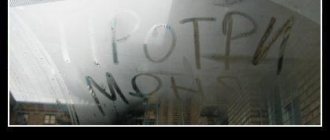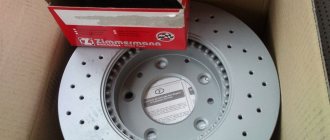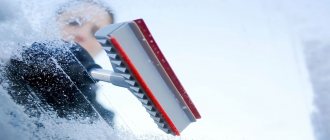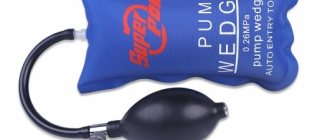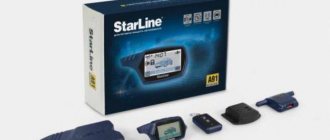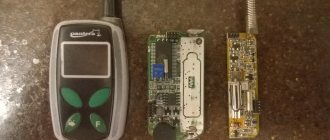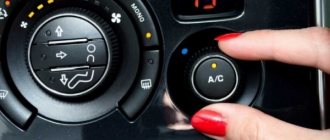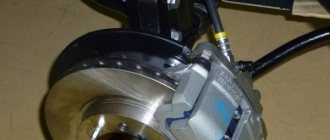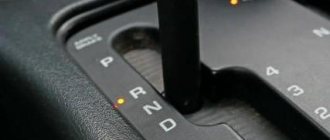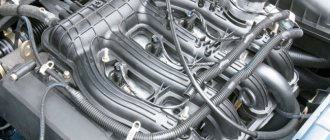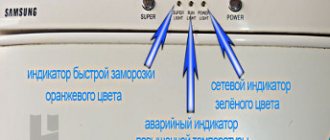Creaking noise when braking. Sometimes when replacing brake pads, the brakes begin to squeak and whistle. The sound is quite unpleasant. Some people endure it, others begin to take action, but what is certain is that no one is indifferent to such a squeak.
Let's try to figure out what the reason is and what to do to get rid of the unpleasant sounds.
The braking mechanism is as follows: we press the brake, the pads, under pressure from the brake fluid, compress the brake disc. Creaking, as we know, is vibration with a certain frequency and, therefore, this sound comes from the vibration of the pads and is further amplified by the wheel arches.
[contents]
Friction part material
Now let's figure out why squeaking occurs when braking. Let’s take the disk material – steel – as an invariable given, and exclude the whistling from the list of causes. This means the reason is in the clutch material.
Manufacturers of original pads, for a well-known reason, keep the friction material secret; their brakes do not squeak. They found their own composition of friction material, which in all respects is compatible with the metal of the brake disc.
It’s important to say here that making friction material is not easy; you need to maintain a compromise ratio of the hardness of the material.
If you make it softer, there will be no creaking, but there will be rapid wear. If you make the material too hard, the braking efficiency will be high, the amount of wear will be low, but the squeaking guarantee will be ensured.
It has already been established that some friction materials are incompatible with the metal of the brake disc and no matter what you do, the brakes will still squeal. Only replacement can help, and only from a different manufacturer. Better than the original ones.
It also happens that after replacing even with original ones, there is still a squeaking noise when braking. Don't worry, the whistling will go away in a couple of days. The manufacturer makes a special layer that wears off in a day or two and the squeak will disappear.
Causes and elimination of squeaking disc brakes
Basic reasons for squeaking:
- novelty of the part (the elements need to get used to each other),
- corrosion of elements, which leads to incomplete contact,
- contamination of moving parts due to wet weather and lack of preventative cleaning after trips.
If you encounter strange noise when braking, then, first of all, check that the system is correctly positioned relative to the brake rotor. There should be no displacements or distortions in the structure, and the clearance between the contacting parts should be the same on all sides and not exceed 5 millimeters.
Features of brake pad designs
Metal plates installed between the base of the pads and the piston of the brake cylinder are sometimes used as a cure for squeaking. Sometimes this saves you from unnecessary vibrations.
Let's look at the design of the block. If there is a creak, then there is a vibration that our ear can hear. It would be logical that if we can change the vibration frequency towards the inaudible range, then we will get rid of the squeaking and whistling of brakes.
Manufacturers use a trick and divide the friction area into parts. They cut grooves and make two or more segments on the clutch. The smaller the segment, the less its mass and the higher the vibration frequency. The main thing is to bring this frequency to a zone close to ultrasound, which is inaudible to the human ear.
As a rule, the depth of these slots is approximately 4 mm, width 2 mm. You can experiment and try to cut it yourself into n number of sectors.
Sometimes the edges of the pads are rounded. In this case, the creaking noise during braking is extinguished due to the gradual increase in pressure of the pads on the disc.
But the noise can also be caused by the brake discs themselves. As a rule, due to their wear, and it usually does not go evenly. A worn disk, if you have seen it, does not have a flat surface, but a wavy one.
If you measure the surface area of a wave-shaped disk, it will be larger than that of a new one, and therefore the vibration frequency will be different.
The disc can be deformed; this happens when a disc heated by braking gets into cold water, for example, into a deep puddle. Here you need to groove the disc or replace it.
A worn-out wheel bearing can also cause squealing brakes, but this is rare.
If a squeak appears, in any case, you should look at the pads and remember when you changed them. Maybe it's just time to replace them.
Many pads have wear indicators (“creaks”). They are plates of soft metal fused into the friction layer. When the pads become critically worn, metal begins to rub against metal, producing an unbearable squealing sound from the brakes. In this case, only replacement will help.
If the squeaks from the brake area are non-standard, be it knocking or periodic grinding without pressing the brake, then you should pay attention to the brake mechanisms. It is possible that your brakes are worn out and require replacement.
The main reasons that increase the squeak (they are the causes of the audible squeak)
1. Mismatch between the disc materials and the friction material of the pads.
Ferodo (pad linings) are made from a special material, the exact composition of which varies for each manufacturer. Ferodo is designed in such a way as to ensure maximum braking effect with minimal wear.
Experienced drivers know that in Zhiguli cars the creaking appeared when the ferodo was almost completely worn out and the disc was braked by the metal part of the pad. Thus, the softer the working material of the pads, the less likely squeaking is, but they will wear out faster.
Very often, drivers purchase “non-original” pads without thinking that they may be the cause of the whistling noise. It is unlikely that their eastern manufacturers thought about the compatibility of materials.
2. Creaks of new pads caused by special spraying or coating.
Often new pads have a special pre-sale coating applied to them. It may cause squeaking. To eliminate it, it is enough to drive for a couple of days, making sharp braking. The squeak should disappear.
3. Design features.
The designs of some types of pads include anti-squeak plates, which are installed to stabilize the position of the pad relative to the piston. This reduces the vibration of the pad and, accordingly, the creaking.
Some car enthusiasts install this element incorrectly or forget it altogether. Sometimes analogue pads are sold complete without such plates. Therefore, it is recommended to familiarize yourself with the design of the standard block in advance.
4. Anti-vibration segments.
Many car enthusiasts paid attention to the segmentation of certain types of pads (slots about 5 mm deep, a couple of millimeters wide). Sellers often explain their presence by self-cleaning of friction dust, ventilation and cooling.
In fact, dividing into segments increases the frequency of the whistle in proportion to the number of segments. If a whistle in a regular block, for example, occurs at the “opposite” frequency of 12 kilohertz, then segmentation into three segments results in a frequency shift of 36 kilohertz, which is inaudible to the human ear.
As an experiment, motorists cut such paths themselves. Sometimes they even file down the edges of the pads, making braking “softer”.
5. Brake disc wear.
Uneven wear on the brake disc often leads to whistling and squeaking noises. It can be checked during the process of replacing the pads.
The cause of such wear may be jamming of the caliper suspension system. It is better not to repair calipers and grind discs yourself: the best option is to have them repaired by specialists. Still, the braking system.
Endless grinding is also not possible. Service programs (AUTODATA) and reference books contain information about the minimum permissible brake disc thickness for each car model.
6. Incorrect brake disc geometry.
This could also be the cause of the squeaking noise. The disc can be bent as a result of an accident or water hammer (driving into a deep puddle at high speed).
7. Wheel bearing wear.
It can make noise when wear appears only when braking, only then will it manifest itself fully.
8. "Squeaky"
Plates that begin to rub the brake disc when the pads wear out. In this case, the creaking is useful as an indicator.
9. Weather conditions.
In winter, ice can get into the working area of the pads; at any time of the year, water, sand, and small stones can get into it. If the creaking does not go away after some time, it is necessary to carry out an inspection and diagnosis.
Video - why the pads whistle when braking and what to do in this case:
Creaking when braking: the reason is dirt
Creaking often occurs in bad weather, combined with poor road conditions.
Dirt, falling on the rubbing surfaces of the pads and disc, interacts with the braking action, making its “dirty” contribution on the negative side. Sand eats into the pads, thereby changing the density of the friction surface and changing the purity of vibrations of the pads.
Plus, sand, working like emery, increases disc wear by making grooves and waves on the braking surface, causing squeaking and whistling.
Causes and elimination of squeaking rim brakes
The reasons are similar to the disc braking mechanism. The only difference is the greater influence of dirt and corrosion elements, since the contact surface is located directly on the bicycle rim.
Always keep the wheel rim clean and carry out maintenance at least once a month. Also, run sandpaper over the rubber pads from time to time. If you carry out diagnostics and cleaning in a timely manner, the unpleasant squeaking of the brake system will never bother you.
Possible causes of squeaking brakes
There are many reasons for squeaking brakes and each is easily eliminated and does not always mean a breakdown.
- Weather. In wet or rainy weather, squeaking brakes is quite normal, as water prevents the smooth adhesion of the surface to the braking system.
- Material. When it comes to rim brakes, the softness of the brake pad is key. Soft analogues practically do not creak, but at the same time they have a shorter service life compared to a block made of hard rubber.
- Wheel rim. Creaking can occur when the rim surface is heavily contaminated or due to wear. This is a rare phenomenon, but it happens that the rim simply “wipes” during many years of braking.
- Brake pad position. Visual inspection allows you to determine the misalignment of the pad relative to the rim. A simple adjustment will correct this defect, which may be the cause of the squeak. Remember, the pad must be positioned strictly parallel to the surface of the rim.
Types of braking systems
There are two popular types of braking systems, each of which has a number of advantages and disadvantages, but this does not prevent them from finding a certain percentage of cyclists who prefer one or the other system.
We are talking about the following braking systems:
- rim brakes;
- disc brakes.
Rims, as the name suggests, interact specifically with the surface of the rim, slowing down its rotation, thereby stopping the vehicle. Rim brakes are also called pincer brakes, due to the principle of squeezing similar to a pincer clamp or V-brake, since in appearance they resemble the letter V.
Disc brakes are a metal plate installed in the wheel hub area that is acted upon by a clamping system that stops the action.
The reason is contamination of the brake discs and pads.
Please note: Over time, grooves appear on the discs. The reason for this is particles of sand, dust, and dirt. Poor quality pads with a large number of coarse abrasive particles also affect this factor. All this wears the surface unevenly:
Wear can also occur due to rusting of the disc. You've probably noticed that after parking for a long time in the rain, the wheels become covered with a brown coating. It doesn't bode well.
Pollution also negatively affects. Dirt literally eats into them, which leads to poor braking.
How to fix the problem.
It is not difficult to clean the surface of the pads; just walk over its surface with low-abrasive sandpaper (marked from 100 to 200). The discs can be cleaned with brake cleaner. If they are very rusty, it is better to replace the brake discs with new ones.
Creaking sound when pressing the brake pedal after replacing the pads
So, you just recently replaced your worn out pads with new ones, but when braking you hear a familiar, annoying squeaking noise. What to do in this case? Did the seller really deceive you and sell you unusable pads under the guise of new ones?
Before jumping to any conclusions, try driving for a few days, noting the intensity and strength of the squeak. Most new pads, especially those not purchased from a dealer, take some time to break in properly. As a rule, the squeak disappears on its own within a few days, during which you will have to endure some, but not critical, instability of braking and an unpleasant sound.
Preventing squeaking brakes
A common cause of squeaking is replacing the brake system. The new system requires grinding into existing parts. For a simple break-in, sharp braking at medium speed is enough. If desired, the procedure can be repeated several times. The main thing is not to be afraid to slow down; it will be useful for new parts to be in operation without a gentle regime.
The second point that is worth paying attention to when the brakes on a bicycle squeak is lubrication and lubricating elements. Lubrication is the main element in the proper operation of bicycle parts.
It is necessary to ensure that moving metal elements do not suffer due to lack of lubricant. Run an oil can over the chassis and the extraneous squeak will go away. Another advantage will be the greater cross-country ability of parts.
Don't forget about simple recommendations. Keep your bike clean and clean after one or more rides. This advice will be especially useful when driving in bad weather. For basic cleaning, it is enough to use ordinary solvent or gasoline mixture. After cleaning, you remove unnecessary elements, thereby increasing the contact area of the pads.

